It's been a long time since I've given a crap about Resident Evil. I loved the classic Resident Evil games. The Play Station original is a foundational game for me, and jump-started my interest in horror and the macabre. I felt like the series jumped the shark with Resident Evil 4, however, and my interest in the series tanked with its abandonment of horror in favor of schlockey action-shooter gameplay. I played through Resident Evil 5's co-op with a friend, but didn't really enjoy myself, and after playing the abysmal demo for RE6, I skipped that one entirely.
So I was genuinely excited by Resident Evil VII: Biohazard. The popularity of first-person horror games, and the phenomenon that was P.T. / Silent Hills (not to mention the success of Resident Evil REmastered on Steam) obviously seems to have kicked Capcom in the butt and reminded them that there is still an audience for genuine horror games - an audience that mainstream gaming has neglected for most of the last decade. I'm not sure if development of REVII started as a response to P.T., or if it was already in the works following the success of games like Amnesia, Outlast, and Alien: Isolation. Either way, it's good to see major publishers embracing the genre again.
The family's new - but familiar - mansion
This new Resident Evil really does go back to the franchise's roots. The early hours of the game actually feel a lot like a combination of the original Resident Evil and Resident Evil 3: Nemesis, but updated with a first-person camera and a lot of modern horror contrivances. Long-time fans of the series will recognize the safe rooms and item-boxes. The classic health status indicator is now part of a watch on the character's wrist that you can see whenever you pull up your inventory. There's a foyer with a balcony. Doors are locked by silly, esoteric puzzle mechanisms that require themed keys, crests or various other stand-ins for keys. There's even a booby-trapped shotgun to tease you at the start of the game. Some of these elements of design feel appropriate, while other ham-fisted call-backs admittedly feel like the developers were trying too hard.
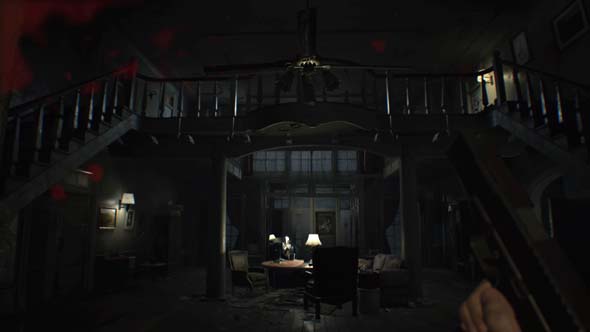
The mansion is new, but has many call-backs to the first game.
The map is well-designed, with its claustrophobic hallways, shortcuts, and lots of visual detail. Lighting is excellent, though the game is a bit too dark at the recommended brightness level (at least without a flashlight), and it becomes washed-out at higher brightness settings. Sound design is also quite exceptional, with the game giving great audio feedback (especially for the pursing stalkers). I also like a lot of the little details, particularly how using a key to unlock a door takes a small amount of time, during which you are vulnerable.
The family also makes for some excellent antagonists, especially compared to the likes of stupid, campy villains like Albert Wesker and Salazar. These villains have a lot of character, and there's enough detail in the mansion to give a sense of who these people might have been before they went off the deep end: the collectible football bobbleheads, for example. And on top of that, they are genuinely disturbing and threatening, and the whole game would probably be scary enough if you just spent the whole time avoiding them and trying to escape their murder house.
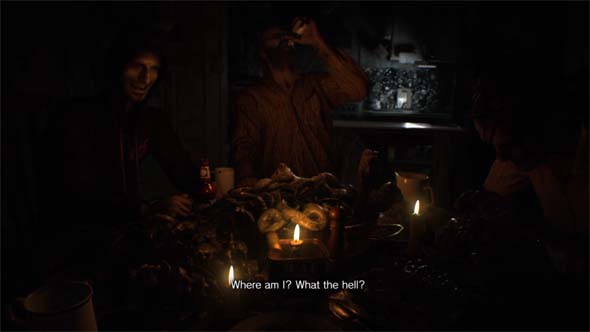
The family makes for genuinely disturbing villains that put RE's earlier villains to shame.
The save system is kind of an odd hybrid of the classic save system and more modern checkpoint systems. The logistics of the classic system have been scaled back, as you no longer require a consumable item (ink ribbon) to manually save (at least not on the default difficulty). But the game will also checkpoint you at certain points, and it maintains a single autosave slot with your checkpointed progress. So if you die to one of the obnoxiously-hard bosses, you don't have to go back a whole hour to your last manual save; instead, you get to restart at the most recent checkpoint.
However, the manual saves still have value, because Biohazard is structurally very similar to the original Resident Evil - both superficially and in terms of gameplay. You start in a house/mansion, explore, solve puzzles, defeat enemies, make your way out to a backyard (of sorts), where you find another house infested with mutated insects and overgrown plants, and so on. Also, a great deal of the challenge is logistical. Conservation and efficient use of resources is a primary game mechanic - even more primary than the actual combat that consumes those resources. Using too many bullets or taking too much damage might cause you to avoid manually saving until you restock your supplies, or at least to manually save in a new save slot. The autosave is just a convenience that spares you from losing too much progress if you die to a boss or a gauntlet of enemies. But, if you decide that the boss or enemy gauntlet is actually over your head, or was too costly, then you can ditch your autosave, go back to the manual save, and try a different path to find better weapons or ammunition. In fact, that specific instance happened to me early in the game!
Inventory, status monitor, safe rooms, and item boxes are all back. But not Ink Ribbons.
The downside is that the autosave allows individual combat encounters to be annoyingly hard. Since there's virtually no cost in dying, the developers are allowed to throw hordes of enemies at the player, to make them difficult to hit so that you waste some bullets on errant shots, and to make bosses obnoxiously overpowered. So even though the logistical gameplay of the original game is retained, the sense of attrition is kind of lost. Taking large amounts of damage or wasting bullets often just caused me to reload from the last checkpoint in order to play better (assuming the encounter didn't outright kill me), instead of powering through and dealing with the long-term consequences. The convenience of the checkpoints takes much of the fear of death away.
The puzzles are also a bit lacking. Aside from the exceptionally well-executed "Happy Birthday" sequence, most puzzles feel like the kind of remedial "turn an object around in your hands" affair that has plagued motion-control games for a while now. This is probably owing to the game being designed for VR, and the amount of things that get shoved in the character's face early in the game definitely showcases how much of the early design was focused around the VR / 3-D experience. There's even one puzzle that is literally "Look at a clock. What time is it?" It's certainly no "In here is a tragedy--"
Familiar problems
The first person perspective actually does provide an intensely suffocating atmosphere and a sense of immersive vulnerability. The perspective is also very well used for some of the game's encounters and gags. The encounter with the first enemy works really well, and is really tense, and the first-person perspective makes it so much more intense and personal. Despite some clever and creative encounters, the game is at its best when you're fumbling around the house scavenging for supplies, clues, and keys to progress, and fearing whether there's an enemy around the corner or beyond that next door. Once you turn a corner or open a door to find an enemy (especially if that enemy happens to be one of the immortal family members), frustrations start to rear their ugly head.
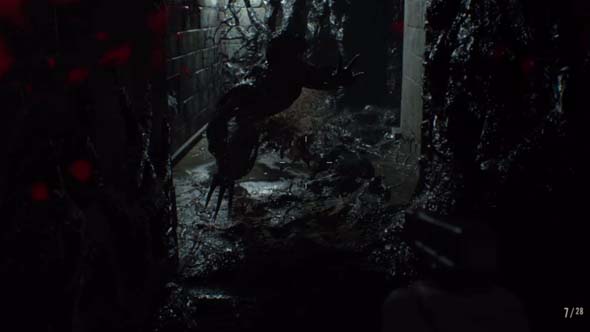
You can shoot out an enemy's leg to slow it to a crawl, but it's always more efficient to go for the head.
I don't care for the combat. Enemies move too quickly, too erratically, and most of them are bullet-sponges. There aren't any easy, shambling zombies to introduce the player to the combat and allow the challenge to be ramped up from there. The very first enemy is an un-killable, hard-hitting, boss that stalks you around the house. The next set of enemies are weird sludge monsters that close the claustrophobic distances rather quickly, also hit fairly hard, and can be annoyingly hard to hit at times. The fastest way to down any enemy in the game is to soot it in the head, and failure to hit its head wastes a lot of bullets. You can shoot out basic enemies' legs to make them crawl around, and you can shoot off their arms to prevent them from attacking, but doing so wastes so many bullets. Heck, when they're on the ground, you can't even step over them in order to move past and get to safety. They completely block the narrow hallways unless they are completely dead, which can leave you unfairly trapped in corners. So why pump two or three shots into a leg or arm to slow down or weaken an enemy slightly, if two or three shots to the head permanently kills it? So it's headshot or bust, which [for me] just makes the combat tedious and thoughtless.
So when the second half of the game starts to degrade into linear corridor-crawls with waves of enemies coming at you, the game goes downhill tremendously. Fortunately, the exceptional first half of the game outweighs the lackluster second half.
Most fights [for me] often devolved to just running circles around some obstacle (a table, for example), and occasionally turning around to try to shoot the thing chasing me. But they're fast enough, and the environments are claustrophobic enough, that I rarely felt like I had enough space to take a shot. Having to repeat this process while I unload two whole magazines into a single bullet-sponge enemy (on Normal difficulty) just got very tedious. Blocking is also kind of a useless mechanic, because I often find myself taking hits when I'm trying to turn around to get away from an enemy, rather than when I'm facing it.
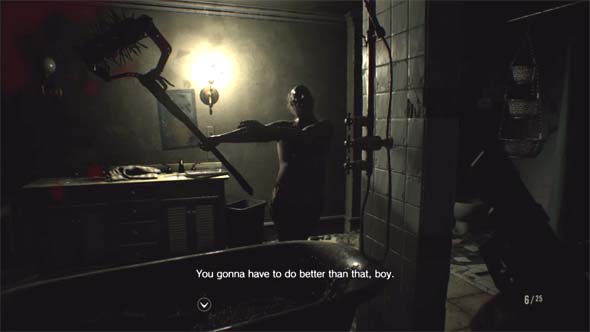
I don't like being stuck in claustrophobic environments with tedious bullet-sponge enemies.
In the game's defense, there do seem to be situations in which the designers' intent was for the player to leave and come back later with better weapons and more supplies. At one point, I came across a gauntlet of enemies while still armed with only the handgun. I drained all my bullets, but the enemies kept coming. I got really frustrated and quit. When I came back the next time, I tried using an old Dark Souls strategy: I tried to kite the enemies back to more familiar terrain where I had an advantage. But when they passed a certain threshold in the environment, they just literally disappeared. It was like they collapsed back into puddles of sludge, and then re-emerged from the walls and floors when I returned to the room that they came from. I was thus left free to explore the rest of the area in relative safety. That exploration uncovered keys to areas that I couldn't access previously, which implied that I was intended to backtrack through those other areas and return to the gauntlet of enemies later. It taught me a valuable lesson: that sometimes the best strategy is a tactical retreat.
The minion enemies are also generally too stupid to open doors. So if you find yourself overwhelmed, you can usually just lock them in a room and explore somewhere else. This is a perfect example of the elegance of open-ended, player-driven exploration and supply management that used to be a staple of survival horror! The problem is that you might not realize that you should retreat and return until you've already expended precious resources, and it's too easy to just go back to an earlier save to avoid the situation entirely.
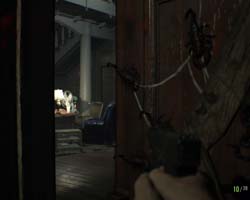
You can door peek, but not corner peek.
Control and visibility problems
Then there's other nagging control and interface issues that make the combat and hide-and-seek systems feel poorly though-out. There's no corner peek or lean mechanic, so if you want to see what's around a corner, you have to expose yourself to any enemy that might be looking for you or waiting to jump out at you. There's also no on-screen indicator for which direction a sound comes from. So you can't peek around corners or tell where a stalking enemy's footprints might be coming from. There is a sort-of door-peek mechanic, in that you can bump up against a door to open it partly, then slowly push through it. But it isn't very reliable. Some doors also refuse to let me close them behind me, and with all the respawning enemies that stalk you through the game, I very quickly got into the habit of closing doors behind me when the game would actually let me.
Perhaps the biggest and most flagrant problem is the apparent lack of a manual flashlight button. This came close to being a deal-breaker for me, as it almost single-handedly makes the game unplayable. The flashlight only comes on at certain scripted places and times, and you can't turn it off or on on your own. At the recommended brightness level, the game is very dark, and it's hard to see what's right in front of your face. I had to go into the options menu and up the brightness well above the recommended level in order to see.
If the developers wanted players to stumble around in the dark occasionally, then they should have just made the flashlight a resource to be managed and given it limited battery power so that you'll use it sparingly. But nothing kills immersion faster than knowing that your character has access to equipment that you (the player) can't use or activate. Especially when that equipment is necessary for something as basic as seeing what the heck's right in front of you!
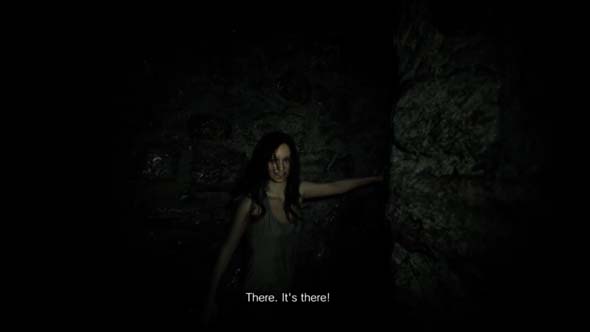
The flashlight only comes on at scripted moments, even though the rest of the game is also too dark to see.
And then there's the little things that have been a problem in Resident Evil forever. Like how you can't pick up an item off the ground and combine it with an item in your inventory if your inventory is full. And you can't temporarily drop an item from your inventory in order to make space for something else that you're planning on immediately using or combining. Ugh.
Capcom also apparently decided to hand out trophies/achievements like candy. After coming off of The Last Guardian - in which my first trophy was awarded on my way to the final boss - I was surprised by just how frequently REVII awarded me with them. After starting up REVII, I took two steps away from the character's car, and was awarded a "thanks for booting up the game" trophy! Have developers started to realize that simply sitting through the lengthy download, installation, and day-one patch update process for their games is enough of a chore that we deserve a trophy for sitting through it all?
For my money, I definitely I still prefer the REmake. But when all is said and done, Biohazard is a return to form for the Resident Evil series, and should hopefully represent a resurgence of the genre that the original Resident Evil almost single-handedly launched. If you're a fan of the original RE games, and a fan of survival horror, then Biohazard is the best Resident Evil game since Nemesis, and it's probably the best traditional survival horror game since Silent Hill 4: the Room.
The missed potential for a more intimate experience
It's kind of unfair to criticize the game for not being something that I would prefer it to be. Like, we should try to look at what the developers actually did do with a game, rather than what we might have wanted them to do. But I feel that this game really misses out on some potential to be a more intimate, personal horror experience.
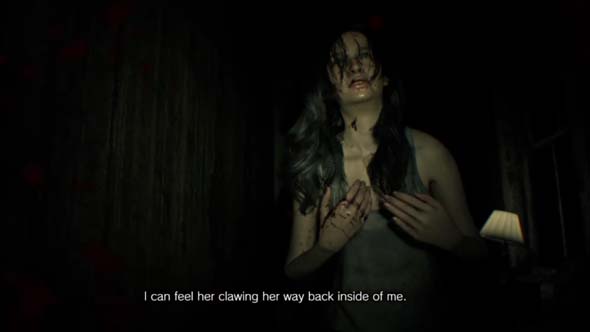
Mia seems possessed and unable to control herself.
The premise of the game is that you are stuck in a house with a crazy, cultish family of immortal zombies who abducts or kidnaps people in order to turn them into zombies as well. The very first zombie that you encounter and fight is your character's ex-girlfriend, Mia, who actually turns back and forth between her zombie and human state during your encounters with her. When you finally finish her off, she even reverts back into her human form. You killed Mr. Hyde, but it's Jr. Jekyll's body that lies on the floor. It humanizes this monster. It isn't just a nameless, faceless, disposable, grunt monster.
Mia alternates between human and zombie form, only to revert to human when killed.
I was hoping for this to be an emphasis of the game. I was hoping that as you progress through the game, you'd learn about the people who had been abducted and turned, and then you'd meet what's left of them face-to-face. The game even seems to build up to this in the first couple hours. You learn the names of some potential victims, find some personal belongings, and even photographs. There's the potential that each and every enemy that you encounter is an actual character, with a backstory - someone that the player can maybe even sympathize with and feel a little bit sorry for having to put them down. Each and every zombie that you encounter and fight would be a little human tragedy. There's a lot of potential there, especially if the game teases at the possibility for a cure that could bring these victims back from the brink (which it does, by the way).
The first couple hours provides a drip feed of information about the previous victims.
But then, near the end of the first act, I wandered into the basement and came across a gauntlet of sludge monsters that literally just crawled out of the walls or dropped from the ceiling. My heart sank a little bit as I realized that this Resident Evil game wasn't going to fulfill its early promise - that it too, would just be a slew disposable monsters that we have no reason to care about, and here's a shotgun so you can blow their heads off without a second thought.